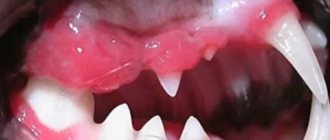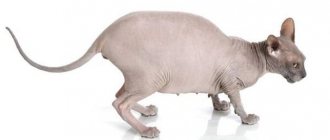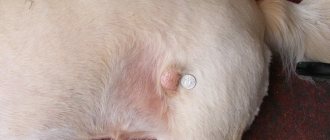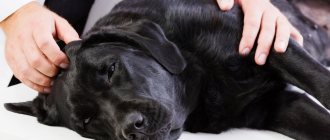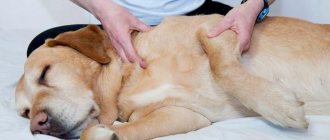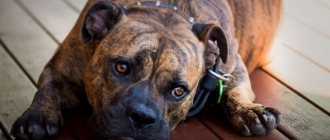What is the disease
Brain lesions in dogs are not as common as in humans. But the results are no less devastating. It is important to notice a stroke in a dog in time, because your furry friend will not complain of poor health or headaches. That's why pet owners should be aware of what to do in such situations. The life and health of the dog will depend on the speed of the owner’s reaction.
Pathology is a violation of cerebral blood supply. Most often, the disease occurs in a furry animal in old age. Such a violation in itself is dangerous, and also difficult to diagnose. The main thing is attention from the person.
In animals, as in people, there are two forms of the disease:
- Ischemic
. It is characterized by blockage of a blood vessel in the head by a blood clot. In this situation, the forecast is more optimistic. However, the severity of the lesion will depend on the location and size of the clot. In any case, the blood does not fully enter the brain, which deprives the organ of oxygen, and against this background hypoxia occurs. The consequences are minor when a blood clot forms in the capillaries.
- Hemorrhagic
. This form is characterized by ruptures of blood vessels. Blood then enters the brain tissue. The effusion of blood forms a hematoma, which puts pressure on the tissues, disrupting their nutrition. This option becomes the root cause of severe results: paresis, paralysis. Animals are at risk of dying.
The disease is divided according to the severity of brain damage. If a small area is affected, it is given the status of local; if large areas are involved, it is given the status of extensive. The more global the affected area, the more serious the consequences may be.
There are also micro-variants of stroke in dogs, which represent blockage of small capillaries. The process proceeds unnoticed and practically asymptomatic. This condition is poorly diagnosed, which is dangerous for pets, as it often precedes damage to larger elements of the circulatory system.
Embolism is considered a separate form of ischemia. A blood clot that has formed in some other place begins to move through the circulatory system to the head section. There it gets stuck and creates negative consequences.
If small capillaries are affected and the affected area is not in vital areas of the brain, the disease goes away unnoticed by the owner. However, this does not mean that everything is normal and the dog is fine.
When the first alarm signals are detected, action should be taken immediately. It is necessary to thin the blood, eliminate inflammatory processes, prevent the problem from spreading, and try to normalize cerebral circulation. The veterinarian will select the necessary medications for these purposes.
Causes of stroke in dogs
The main cause of a stroke in a dog can be attributed to physiological pathology in the pet’s body.
Ischemic stroke in a dog is associated with blockage of blood vessels. Provoking factors include:
- Poisoning by poison
, organic solvents, pesticides. Harmful elements have a bad effect on the permeability of blood capillaries. As a result, thromboembolism occurs. It happens that blockage of blood vessels is facilitated by the active use of numerous medications, as well as narcotic substances.
- Helminthiasis
. Parasites can penetrate into the head, clogging large arteries.
- Various types of illnesses lead to traumatic situations
: damage, wounds, concussions.
- Problems in the heart
, including circulatory abnormalities (congenital or acquired).
- Common reasons include diabetes
, thyroid diseases - all disorders associated with hormones.
- Liver pathology
or
urinary system
. - Oncological diseases
.
- Capillaries often become clogged cholesterol plaques
, which form on their walls when fat metabolism is disrupted.
Obesity
can cause illness.
As for the hemorrhagic version of the problem, it is characterized by capillary rupture and increased blood pressure.
The following factors can lead to an unfavorable situation:
- Stress
. Small dogs are susceptible to psycho-emotional stress. Various negative aspects of a pet’s life can lead to hypertension. For example, moving to another house, losing a significant person. More emotional animals get stressed when switching to a different diet, during treatment, etc.
- Physical inactivity
. This option is typical for larger breeds. If you do not pay due attention to stress and long walks, this can negatively affect the elasticity of the capillary walls.
- Head injuries
. After a strong blow, your pet should definitely be taken to the veterinarian, especially if his age tends to be advanced.
Veterinarians believe that apoplexy in dogs is caused by improper development of blood vessels in the head and autoimmune pathologies, which are accompanied by increased blood clotting. Elderly pets and large breeds are at risk. For example, St. Bernard, Bullmastiff, Great Dane. Brachycephalics are susceptible to circulatory disorders in the brain. The risk group also includes unbalanced individuals with an increased psycho-emotional reaction.
Animals that live within the city are more likely to get sick, unlike their counterparts living in rural areas.
Types of stroke and causes
Ischemic stroke occurs due to blockage of blood vessels in the brain. It can be triggered by:
- poisoning with toxic substances;
- worms that have migrated to the brain;
- head injuries;
- cardiovascular diseases;
- liver diseases;
- diabetes;
- diseases of the urinary system.
We recommend reading: What factors indicate that a cat has not passed the placenta?
Hemorrhagic stroke occurs due to rupture of blood vessels in the brain as a result of thinning of the walls or increased pressure. The cause may be stress or overexertion.
Adult dogs over seven years of age, representatives of large breeds, pets living in large cities, and animals with an unbalanced psyche are more prone to stroke.
First alarming symptoms
Often, only a veterinarian can identify the symptoms of a stroke in dogs. Stroke manifests itself most clearly, while microstroke may go unnoticed in some cases. However, the owner himself is able to show attentiveness and see some signs - the dog begins to behave unusually in any case.
Signs of a canine stroke
The first thing that should concern the owner is:
- Asymmetry of the muzzle, protruding tongue. You can notice sagging cheeks and a drooping eyelid on one side.
- The pupils will not be the same size.
- There is a problem with vision, poor orientation in space.
- A furry friend will behave in ways that are not typical for him in everyday life. For example, move in a circle, back away, walk sideways.
- Your pet friend will not be able to control the process of salivation. It will be noticeable.
- The victim will begin to drag his paws. In quite critical cases, paralysis occurs.
- It becomes difficult for the pet to cope with the muscles of the mouth. He will refuse food completely or partially.
- In some cases, the dog does not even recognize the owners. The state can be depressed, lethargic, or, conversely, aggressive.
- The process of excretion of feces and urine also ceases to be controlled.
- Convulsions are possible.
- Sometimes loss of consciousness occurs.
- Coma. The furry friend may lie still with glassy eyes and an open mouth.
It is not uncommon to experience several symptoms at once. Even if it is not a stroke, you still need to call a doctor - any deviation from the list may indicate a serious illness.
Signs of a mini-stroke in dogs
With a microstroke, the condition of the four-legged friend is less severe. However, the animal will still look tired, depressed, and may find itself walking on the street, eating, drinking, or responding to the owner’s voice. The worst thing is if the micro-stroke went unnoticed. This happens not only in animals, but also in people.
Since older animals are at risk, be sure to examine your pet daily. This will help to detect signs of any illness in a timely manner and quickly cure it.
What you should be wary of:
- lethargy, reluctance to move;
- refusal to eat and possibly drink;
- hemorrhage in the eye;
- causeless and sudden manifestation of aggression;
- disorientation in space;
- poor reaction to sounds or movement.
It is not necessary that all these signs should appear at the same time - one is enough to take the animal to the veterinary hospital as soon as possible.
Symptoms of problems with cerebral circulation in an elderly person will be the same. However, due to age, vomiting, the presence of red eyes, twitching or muscle tone, and fixation of the body in one position are added.
If signs of a stroke are detected in a dog, first aid is necessary. It can be provided by the owner himself before the patient is handed over to the doctor.
What does a stroke feel like?
It happens that the owner of an animal only suspects a stroke, but in fact another disease is discovered in the four-legged animal.
Since we are talking about damage to the brain, the symptoms will be similar to problems in the head area. Sometimes a stroke can be confused with head injuries (particularly concussions). If you notice that your dog has hit his head hard, be sure to take him to the clinic. Even if you don't see any symptoms, it's better to be on the safe side and take a photo.
In severe cases, we are talking about tumors or meningoencephalitis. The symptoms of these diseases are very similar to a stroke, so it is important to make a correct diagnosis. This can be done in well-equipped veterinary hospitals.
How to recognize a disease in a four-legged animal
It is important to notice the first signs of a stroke as soon as possible in order to begin treatment in a timely manner. It is easy to confuse such feelings with similar conditions. For example, with meningoencephalitis, when inflammatory processes occur in the membranes of the brain.
Coordination can be impaired in central and peripheral vestibular syndrome. Similar symptoms are possible if there are oncological problems or traumatic brain injuries. The root cause can only be determined in a veterinary clinic after examination.
The main sign of cerebral hemorrhage is paresis or paralysis of the paws and other parts of the muscular system. The remaining symptoms are very similar to other disorders in the brain and circulatory system.
To determine the cause of the animal’s poor health, the doctor performs detailed neurological studies, analyzes blood and urine. If necessary, an ultrasound examination of the abdominal area, X-ray of the lungs, CT or MRI is performed. An electroencephalogram and cerebrospinal fluid analysis are often used.
Classification of strokes
| according to the nature of vascular damage | ischemic hemorrhagic embolic occlusive (after cervical trauma) |
| according to the location of the brain lesion area | stem cortical cerebellar subcortical diencephalic |
| by size of affected brain area | small focal multiple widespread |
| duration of neurological disorders | incoming long-lasting |
Most often, there are two types of strokes: 1) Hemorrhagic (blockage of blood vessels) Injuries and poisoning with anticoagulants (for example, rat poison) lead to hemorrhagic stroke. 2) Ischemic (bleeding in the brain as a result of destruction of the walls of blood vessels) Brain tumors can cause both hemorrhagic and ischemic stroke.
The disease is quite rare. It most often affects older dogs. There is no clear breed, but large breeds prevail in percentage terms.
- hyperexcitable dogs - large breeds - older dogs - city pets - with a history of many chronic diseases
It may arise independently. It also manifests itself as a complication of the following diseases:
- long-term hypertension (high blood pressure)
- hypothyroidism (low thyroid function)
- Cushing's syndrome (hyperadrenocortism)
- heart disease
- kidney diseases
- liver diseases
- thyroid problems
- diabetes
- obesity
What diseases can be confused with a stroke • Traumatic brain injury • Brain neoplasm • Peripheral vestibular syndrome • Central vestibular syndrome • Inflammatory diseases of the brain (meningoencephalitis)
Symptoms of a stroke
(neurological symptoms affect the side opposite the affected cerebral hemisphere)
The dog is outwardly frightened, does not respond to commands, walks around the room aloofly - this is what first catches your eye. A more detailed examination reveals focal and cerebral symptoms.
focal
- hemiparesis (one-sided muscle weakness)
- hemiplegia (one-sided paralysis)
- deviation of the head and limbs (deviation to the side)
- nystagmus (uncontrolled movements of the eyeballs)
- strobism (squint)
- facial paralysis (upper lip droops, drooping eyelid - facial asymmetry)
- Horner's syndrome (prolapse of the third eyelid, constriction of the pupil, retraction of the eyeball)
- generalized incoordination of movements
- inactivity or overexcitement
- hyperkinesis (involuntary movements)
- epileptiform syndrome (convulsions)
In severe cases, manege (in a circle) movements are observed (extensive cortical stroke), impaired swallowing reflex, gaping of the anus, “bow pose” (muscle tension)
| If you suspect a stroke, you should immediately contact your veterinarian. A plastic carrier is required for transportation to the veterinary clinic. Lay the dog on its side and monitor its condition to prevent vomiting and excessive salivation. |
Clinical diagnosis
- neurological examination
- General and clinical blood test
- Analysis of urine
- X-rays of light
- Abdominal ultrasound
- tomogram or MRI of the brain
- cerebrospinal fluid analysis
The prognosis for recovery is 50% of deaths in the first 3-5 days, then the prognosis is more favorable, but the animal does not always recover completely and requires lengthy recovery procedures.
Treatment
First stage Immediate actions are aimed at:
| establishing breathing control | |
| cardiovascular system | sulphocamphocoin, cordiamine |
| preventing cerebral edema | diuretics: furosemide, mannitol, mannitol corticosteroids: prednisolone, dexamethasone orally glycerin (pre-mix with distilled water in equal parts, drink at the rate of 1 ml per 1 kg of dog weight) |
| localization of the affected area | ascorbic acid, tocopherol |
| preventing recurrent strokes | !strictly under control! intravenously pentoxifylline, trental, complamin, xanthinol nicotinate antispasmodics: no-spa, papaverine, with caution aminophylline |
| restoration of metabolic processes in the affected area of the brain | cerebrolysate, cogitum |
| removal of psychomotor agitation and convulsive readiness | relanium, seduxen sodium oxybutyrate or lithium oxybutyrate (has anti-edematous properties |
The second stage is regular therapy for 10-15 days, in severe cases 1-1.5 months
We recommend reading: All Lichens are Transmitted from Cat to Human
diuretics (course 3-7 days) cardiac drugs antispasmodics
| Continuation of the course | |
| To improve blood flow to the brain | nicotinic acid, complamine, xantathinol nicotinate |
| To improve brain function | nootropics: cerebralysin, nootropil, piracetam, complamin, B vitamins |
| For paralysis | proserine, galantamine, strychnine sulfate |
| Relieving seizures | pargluferal anticonvulsants: benzonal, hexamidine |
| Removing muscle tone | mycodalm, levodopa, nacom, norakin |
A course of follow-up treatment to stabilize the condition, usually after 3 weeks, lasting 2-3 weeks. Injectable drugs are replaced with tablet form. They are taken 2-3 times
- Nootropics: piracetam, pyriditol, aminalon, encephabol - Vascular drugs: Cavinton, Complamin, Vinpocetine, Stugeron, antispasmodics - For hypertension (high blood pressure): papazole, Enap, anaprilin - A course of massage is necessary during the recovery period.
Diet - light diet - split meals up to 6 times a day - canned food or semi-liquid food
Prevention - regimen - proper rest - moderate physical activity. loads - diet - protect the dog from stress
(neurological symptoms affect the side opposite the affected cerebral hemisphere)
Providing independent first aid
Treatment in this case does not require delay - you should immediately get help at home. Even if you worry in vain, help will be useful. The main thing is not to delay it and not cause harm by performing meaningless and unprofessional actions. The best option would be to call the veterinary clinic and provide first aid under the guidance of a doctor.
What can you do with caution?
If you feel like you don't have time to make a call, follow these simple steps
:
- remove the collar and anything that may interfere with breathing and movement;
- Lay the sick person on his side - the head area should be in a comfortable position (in case of nausea);
- if vomiting was observed, then all secretions should be removed from the mouth;
- Talk quietly and kindly to your pet, calming him and stroking him.
Never give medications without a doctor's prescription. You can only use herbal sedatives - again, with the approval of the veterinarian at the other end of the line. He will recommend making a weak solution of motherwort or valerian (less than 15 drops). The substance is diluted in water and slowly poured into the mouth. The main thing is that water does not enter the respiratory system. Do this with a syringe without a needle.
What is prohibited to do
Some actions of owners can harm the pet, so you should be well aware of what not to do:
- You cannot give water to an animal if it is unconscious or has convulsions, foam at the mouth, or vomiting;
- under no circumstances give any medicines or give injections until the doctor himself says so;
- do not cool the sick person’s head and do not wrap him up to prevent overheating;
- Don’t create panic, noise and fuss: this will only make the situation worse.
Ideally, you should first call the veterinarian, and then carry out the treatment measures that he recommends.
Diagnostics and treatment in the clinic
After your furry friend has calmed down a little, you should immediately take him to the clinic. You can call a doctor at home, describing all the symptoms. He will recommend introducing some medications - if you know how to give injections. Remember that you cannot hesitate with such an illness.
But self-treatment of stroke in dogs is contraindicated unless you are a veterinarian. Some human medications can be harmful to pets. Do not apply ice compresses to the patient's head. This spasms the blood vessels, worsening the already poor condition of the sick pet.
Treatment should be carried out by a professional.
The veterinarian will select the necessary medications that will help restore blood circulation, based on the severity of the disease and the age of the animal. Basically you will need to give injections.
It is better to leave a weak pet in a hospital hospital first. Once the patient is in a stable condition, injections can be easily administered by the owner himself or a visiting nurse, based on the dog doctor’s prescriptions.
Rehabilitation and pet care
In addition to medications, you should properly care for your pet, who is weakened during this period. An animal will recover from illness in an average of two months. There is no guarantee that it will behave the same way as before the disease.
You should strictly follow the doctor’s instructions and give the necessary medications on time. The cardiovascular system, metabolic processes, and blood circulation in the cranial region should be kept under control. It is important to create a calm atmosphere in the home.
Organize a comfortable place for your patient - not too soft, but warm. It is important to change the litter more often and regularly clean it from dirt. If there is paralysis, be sure to turn your pet over to prevent the formation of bedsores. Paw massage helps a lot. Be sure to treat the sutures, if there was surgery, make sure that the pet does not lick them.
Therapeutic diet
Most likely, during the first couple of days, being in the acute phase, the animal will completely refuse to eat. He will only need water. As soon as the pet feels better, he will want to eat, and a special diet should already be prepared for him.
The main principle of a therapeutic diet after a stroke is to feed often, little by little, and crushed food. Ideally, it will be a puree of boiled lean meat and vegetables. Veterinarians strongly recommend NOT using baby food, but preparing your dog's food yourself.
If your dog is used to eating dry food, then it should be given in a soaked form. For the first week you can make do with pates and pouches. There is a high probability that the food will have to be replaced with medicinal food: the brand, quantity and frequency of feeding will be recommended by the attending veterinarian.
On average, the first couple of weeks the dog should eat small meals 5-6 times a day. Once she feels better, you can start adding larger pieces of food, and then completely switch to regular food.
What is the prognosis for recovery?
Unfortunately, no one, not even the most experienced veterinarian, can say for sure how quickly the dog will recover and whether this will happen completely. Some individuals recover quickly, and no trace remains of the stroke, and some retain traces of the illness until the end of their lives.
In any case, at the very beginning of the disease you should not think about this: all your efforts need to be invested in treatment. With proper care and therapy, any dog (even an older one) will get back on its feet and live several more happy years.
The pet’s recovery directly depends on the owner’s mood, therefore, even if veterinarians do not promise miracles, one should not give up. Love and care always work wonders and help even in the most difficult cases.
Possible complications
A stroke and even a mini-stroke are serious damage to the blood vessels of the brain. This means that sooner or later the consequences will show themselves if proper treatment is not carried out in time. If the dog was observed by a specialist throughout the illness and received the necessary care, the likelihood of complications tends to zero.
Most often, residual effects appear in older dogs. These include partial paralysis, slight limp or imbalance in gait, and decreased vision or hearing. This does not always cause discomfort to the animal and its owner.
In any case, even the most severe, every dog has a chance of recovery and a decent life. The main thing is to approach the issue of care responsibly.
How to help an animal with a microstroke (stroke)
First aid
If the owner has detected all the signs of a micro-stroke or stroke in a dog, treatment at home can lead to irreversible consequences. In case of these diseases, only a timely visit to a veterinary hospital will be the maximum that a loving owner can do for his four-legged friend.
Here are some recommendations that may help:
- To properly transport an animal to the clinic, you need to move the animal as carefully as possible onto a flat, hard surface and lay it on its side;
- When transporting your pet to the doctor, it is necessary for someone to support the animal's head;
- There is no need to apply ice to the animal’s head under any circumstances! This harmful advice, which is replete with some publications, can only aggravate the pet’s condition;
- You should not give your dog any medications that can be recommended by familiar animal lovers - all cases are unique, so only a doctor can prescribe treatment for an animal! Remember this;
- As an exception, you can only give the animal a light sedative, the use of which has been tested repeatedly in practice with this pet. Such a medicine can slightly reduce the dog’s suffering.
Read also: The best rehabilitation after a stroke
After the veterinarian confirms the diagnosis, treatment is prescribed , which will consist of certain stages:
- First aid provided urgently in the clinic - this will determine how quickly the dog recovers and whether its health can be fully restored;
- Therapeutic treatment with drugs - they are prescribed only by a veterinarian after diagnosis. What medications are commonly prescribed: vitamins, cardiovascular medications, antispasmodics, nootropics (neurometabolic stimulants used to stimulate brain function), antioxidants, tranquilizers.
- You can only take medications that were prescribed by the treating veterinarian, strictly according to his recommendations. The course of treatment is usually about 6 weeks.
Unfortunately, a stroke or micro-stroke very rarely goes away without negative consequences for the animal. After suffering an illness, some pets never regain normal motor activity, some remain partially paralyzed.
In fact, a loving owner is quite capable of coping with all this. But this will require certain effort, time, and, of course, desire. Accurate implementation of the doctor’s recommendations, care, massage courses and good care - all this will contribute to the fastest possible recovery of your pet.
Rehabilitation period
It is advisable that the dog spend the first few days after the diagnosis of “stroke” or “mini-stroke” under the supervision of a veterinarian (in a hospital).
Throughout the recovery period:
- Make sure that the dog’s bedding is warm and not too soft, and always remains dry and clean (involuntary urination or bowel movements are possible);
- To avoid the appearance of bedsores, your four-legged friend must be periodically turned over to the other side;
- Massage the paralyzed side of the body and limbs;
- Avoid drafts - in this state, a pet can very easily “catch” pneumonia;
- Follow the diet and feeding regimen prescribed by your doctor.
Is it possible to avoid a stroke?
If your pet is at risk, then proper preventive measures will help protect him from this disease. What will contribute to this:
- Daily long walks without strong physical activity: games and running should be in moderation;
- Limit your pet's exposure to the open sun;
- Try to avoid stressful situations;
- Monitor your shaggy friend’s diet to avoid the risk of obesity;
- If a dog has chronic pathologies of the cardiovascular system, then it is necessary to constantly monitor their condition. To do this, you need to periodically examine the animal in the clinic.
Following all these simple recommendations will help reduce the risk of a stroke or mini-stroke in your pet. Remember, it is your love and care, as well as proper care, that will allow your dog to lead a full life and give you his devotion for as long as possible.
Preventive measures, or how to protect your dog
Prevention of this disease will be to limit active physical activity in the heat and scorching sun, especially for older individuals. Feed your pet correctly, avoiding excess food - otherwise you can provoke obesity.
Try to create a comfortable atmosphere in your home. Don't scare your furry friend, especially while sleeping. Protect your pet from stress. Treat all diseases on time, do not let them take their course. It is important to undergo regular examinations by a veterinarian and get tested.
A stroke in a furry friend has a wide range of consequences. If you find signs of it in your dog, then the first aid is to immediately take the animal to a veterinary clinic. The disease is dangerous, and you cannot hesitate at the slightest suspicion.
The article is for informational purposes only. Contact your veterinarian!
First aid
Within 3 hours after the first signs of the disease appear, it is important to provide proper medical care.
In this case, the chances of recovery are significantly increased.
At home
Before going to the veterinary clinic, the owner needs to remove the collar and lay the animal on its side on a flat, hard surface. If your dog starts vomiting, it is important to prevent the animal from choking on the contents of its stomach.
Forbidden
Do not apply cold to your pet's head .
This technique only helps with injuries; if there is hemorrhage, it will only worsen the situation. Taking various medications is also not recommended - this makes diagnosis difficult.

